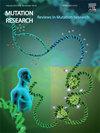SIRT6 regulates the HIPK2/P53 pathway to reduce oxidative stress and apoptosis to attenuate vancomycin-induced nephrotoxicity
IF 1.9
4区 医学
Q4 BIOTECHNOLOGY & APPLIED MICROBIOLOGY
Mutation Research-Fundamental and Molecular Mechanisms of Mutagenesis
Pub Date : 2025-01-01
DOI:10.1016/j.mrfmmm.2024.111897
引用次数: 0
Abstract
SIRT6 is known to play a protective role in several kidney diseases; however, its role in vancomycin-induced renal injury remains unclear. This study aims to confirm the role and related mechanisms of SIRT6 in vancomycin-induced renal injury. To develop a kidney damage model, mice were given vancomycin injections for seven days. Additionally, an in vivo transfection with a SIRT6 overexpression plasmid was performed. PCR and Western blot analyses were used to assess the SIRT6 mRNA and protein expression levels in renal tissue. HE staining was performed to evaluate renal tissue damage, while Scr and BUN were measured using specialized kits. Renal tissue apoptotic cells were labeled using a TUNEL kit, and the levels of the antioxidant enzymes SOD and GSH were measured using appropriate kits. Western blot was used to identify HIPK2, p-p53, and p53 protein expression in the renal tissue. The results reveal that SIRT6 is expressed at markedly low levels in renal tissue. Furthermore, mice administered vancomycin exhibited a significant increase in Scr and BUN levels, indicating impaired renal function. Histological examination through HE staining demonstrated considerable damage to the renal tissue of the vancomycin group. Additionally, the renal tissue of the mice in the vancomycin group displayed reduced levels of the antioxidant enzymes SOD and GSH, an increased number of TUNEL-positive cells, and significantly elevated levels of HIPK2 and p-p53 protein expression. Moreover, the mice transfected with SIRT6 exhibited significant improvements in previously described symptoms. These findings imply that the inhibition of HIPK2/p53 by SIRT6 may represent a promising therapeutic strategy for alleviating vancomycin-induced nephrotoxicity.
SIRT6调节HIPK2/P53通路,减少氧化应激和细胞凋亡,减轻万古霉素引起的肾毒性
已知SIRT6在几种肾脏疾病中发挥保护作用;然而,其在万古霉素引起的肾损伤中的作用尚不清楚。本研究旨在证实SIRT6在万古霉素致肾损伤中的作用及相关机制。为了建立肾脏损伤模型,小鼠被注射万古霉素7天。此外,用SIRT6过表达质粒进行体内转染。采用PCR和Western blot方法检测肾组织中SIRT6 mRNA和蛋白的表达水平。HE染色评估肾组织损伤,Scr和BUN用专用试剂盒测定。采用TUNEL试剂盒标记肾组织凋亡细胞,采用相应试剂盒检测抗氧化酶SOD和GSH水平。Western blot检测肾组织中HIPK2、p-p53和p53蛋白的表达。结果显示SIRT6在肾组织中表达水平明显较低。此外,给药万古霉素的小鼠Scr和BUN水平显著升高,表明肾功能受损。HE染色组织学检查显示万古霉素组肾组织损伤明显。此外,万古霉素组小鼠肾组织中抗氧化酶SOD和GSH水平降低,tunel阳性细胞数量增加,HIPK2和p-p53蛋白表达水平显著升高。此外,转染SIRT6的小鼠在先前描述的症状中表现出显着改善。这些发现表明SIRT6抑制HIPK2/p53可能是缓解万古霉素引起的肾毒性的一种有希望的治疗策略。
本文章由计算机程序翻译,如有差异,请以英文原文为准。
求助全文
约1分钟内获得全文
求助全文
来源期刊
CiteScore
4.90
自引率
0.00%
发文量
24
审稿时长
51 days
期刊介绍:
Mutation Research (MR) provides a platform for publishing all aspects of DNA mutations and epimutations, from basic evolutionary aspects to translational applications in genetic and epigenetic diagnostics and therapy. Mutations are defined as all possible alterations in DNA sequence and sequence organization, from point mutations to genome structural variation, chromosomal aberrations and aneuploidy. Epimutations are defined as alterations in the epigenome, i.e., changes in DNA methylation, histone modification and small regulatory RNAs.
MR publishes articles in the following areas:
Of special interest are basic mechanisms through which DNA damage and mutations impact development and differentiation, stem cell biology and cell fate in general, including various forms of cell death and cellular senescence.
The study of genome instability in human molecular epidemiology and in relation to complex phenotypes, such as human disease, is considered a growing area of importance.
Mechanisms of (epi)mutation induction, for example, during DNA repair, replication or recombination; novel methods of (epi)mutation detection, with a focus on ultra-high-throughput sequencing.
Landscape of somatic mutations and epimutations in cancer and aging.
Role of de novo mutations in human disease and aging; mutations in population genomics.
Interactions between mutations and epimutations.
The role of epimutations in chromatin structure and function.
Mitochondrial DNA mutations and their consequences in terms of human disease and aging.
Novel ways to generate mutations and epimutations in cell lines and animal models.

 求助内容:
求助内容: 应助结果提醒方式:
应助结果提醒方式:


